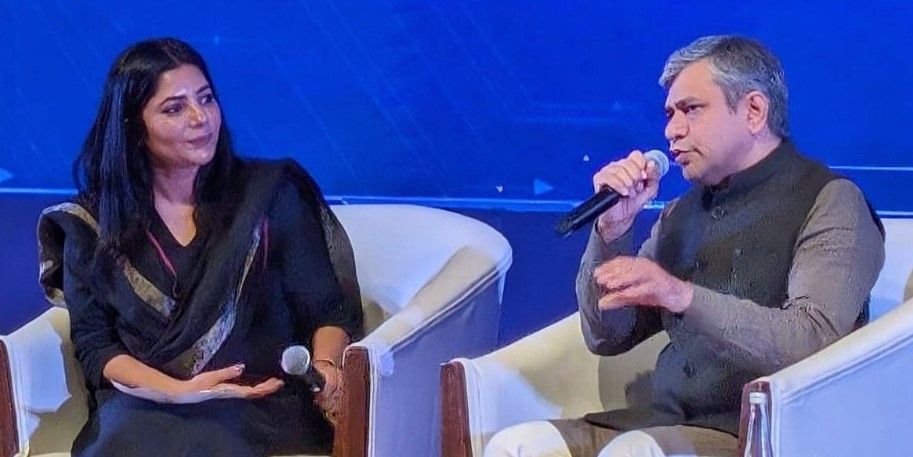
India’s time in the tech sun has finally come. From being a back office of the world and passive consumers of technology even a decade-and-a-half ago, the country is now being seen as an active “co-creator, developer, leader, and one of the largest ecosystems in emerging technologies”, believes Ashwini Vaishnaw, Union Minister for Railways, Communications, and Electronics & IT.
The Honourable Minister was speaking at the launch of India’s first homegrown app store—Indus OS—by .
In conversation with YourStory Founder and CEO Shradha Sharma, Vaishnaw outlined the three pillars on which India’s march towards a thriving ‘techade’ will hinge upon: a) telecom exports and 6G, b) indigenous handsets, and c) semiconductors. “We will keep a laser-sharp focus on some technologies, and develop them in a way we have built Vande Bharat or India’s digital stack. A series of technologies would be developed and exported. And that’s the journey we will take forward in PM Modi’s third term,” he explained.
Telecom, the Minister said, has been one of the biggest turnaround stories for the country. “Gone are the days when you would think of the 2G scam when you heard of telecom,” he quipped, adding, “Telcom has come out of a very difficult period and is now a sunshine industry. The entire world is commending our 5G rollout, and we are already the second-largest 5G ecosystem in the world.”
Interestingly, a majority of the equipment used in the 5G rollout has been ‘made in India’—something the government wears on its sleeve with pride. The Minister also revealed that India is gearing up to export “complex telecom equipment” worth billions of dollars to the US and Europe by 2025.
“The telecom stack is getting rolled out now, and these are some cutting-edge equipment that are expected to cause significant disruptions in the sector,” he said.
<figure class="image embed" contenteditable="false" data-id="538596" data-url="https://images.yourstory.com/cs/2/dc9aa1302d6c11e9aa979329348d4c3e/GG3BxlGa0AAbCCv-1708525533132.jpg" data-alt="Indus AppStore launch" data-caption="
Ashwini Vaishnaw, Union Minister for Railways, Communications, and Electronics & IT in conversation with YourStory Founder and CEO Shradha Sharma at the launch of PhonePe’s Indus Appstore in Delhi.
” align=”center”> Ashwini Vaishnaw, Union Minister for Railways, Communications, and Electronics & IT in conversation with YourStory Founder and CEO Shradha Sharma at the launch of PhonePe’s Indus Appstore in Delhi.
.thumbnailWrapper
width:6.62rem !important;
.alsoReadTitleImage
min-width: 81px !important;
min-height: 81px !important;
.alsoReadMainTitleText
font-size: 14px !important;
line-height: 20px !important;
.alsoReadHeadText
font-size: 24px !important;
line-height: 20px !important;

India is also looking to take the lead in the global 6G rollout over the next five years. The government expects 6G tech to go mainstream by 2029, with India well-positioned to manufacture and export both software and hardware for the new technology.
For the latter, particularly, a ‘Made in India’ handset brand is already in the works, and homegrown app distribution platforms like the Indus Appstore are tailored to power it.
Vaishnaw shared, “We will create the entire handset ecosystem in the country. Our initial success with having large-scale mobile manufacturing [for foreign brands] has given us some very good learnings, and has also provided an impetus to ecosystem partners to come to India in the next five years.”
Semiconductors, too, remain one of the biggest dreams and targets of the current government, and the first indigenous chip rollout is expected in December 2024. “The Micron plant is a success story. And very soon, we will see 2-3 more such approvals,” the Minister shared. “Our target is to have 3-4 high-volume semiconductor fabrication plants, and create a niche and a leadership in at least one category,” he added.
Vaishnaw also commended India’s design ecosystem, which he believes is the “best in the world”. “How we move from being a back office to a product development ecosystem will lead us to the ‘Vikasit Bharat@2047’,” he stated.
Edited by Saheli Sen Gupta










